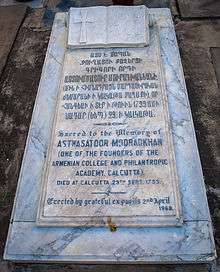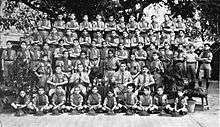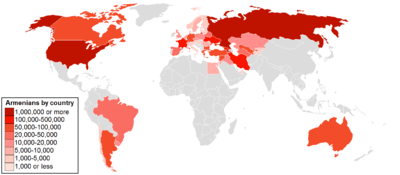Armenians in India
| Part of a series on |
| Armenians |
|---|
| Armenian culture |
|
Architecture · Art Cuisine · Dance · Dress Literature · Music · History |
| By country or region |
|
Armenia · Nagorno-Karabakh Republic Armenian diaspora |
| Subgroups |
| Hamshenis · Cherkesogai · Armeno-Tats · Lom people · Hayhurum |
| Religion |
|
Armenian Apostolic · Armenian Catholic Evangelical · Brotherhood · |
| Languages and dialects |
| Armenian: Eastern · Western |
| Persecution |
|
Genocide · Hamidian massacres Adana massacre · Anti-Armenianism |
|
Armenia Portal |
The association of Armenians with India and the presence of Armenians in India are very old, and there has been a mutual economic and cultural association of Armenians with India for the last several centuries. Their presence has enriched India in several ways.
Antiquity
Armenians are believed to have come to India, when some Armenians joined the auxiliary elements of the forces under the command of Alexander the Great when he crossed Armenia en route to India. The earliest documented references to the mutual relationship of Armenians and Indians are found in Cyropaedia (Persian Expedition), an ancient Greek work by Xenophon (430 BC – 355 BC). These references indicate that several Armenians traveled to India,[1] and they were well aware of land routes to reach India, as also the general and political geography, socio-cultural milieu, and economic life of the Indian subcontinent.
History

Armenians had trading relations with several parts of India, and by the 7th century a few Armenian settlements had appeared in Kerala, an Indian state located on the Malabar Coast. Armenians controlled a large part of the international trade of the area, particularly in precious stones and quality fabrics.
An archive directory (published 1956) in Delhi, India states that an Armenian merchant-cum-diplomat, named Thomas Cana, had reached the Malabar Coast in 780 using the overland route.[2] Seven hundred years thereafter, in the year 1498, Vasco da Gama reached the Malabar Coast by sea. Thomas Cana was an affluent merchant dealing chiefly in spices and muslins. He was also instrumental in obtaining a decree, inscribed on a copperplate, from the rulers of Malabar, which conferred several commercial, social and religious privileges for the Christians of that region. In current local references, Thomas Cana is known as "Knayi Thomman" or "Kanaj Tomma", meaning Thomas the merchant.
The Armenians in India can justly be proud of a glorious past but their present and future are not at all bright. They have greatly decreased in number. Now there are hardly 100 Armenians in India, mostly in Kolkata, where the Armenian College still functions.

Settlements
Several centuries of presence of Armenians, described as "The Merchant Princes of India", resulted in the emergence of a number of several large and small Armenian settlements in several places in India, including Agra, Surat, Mumbai, Kanpur, Chinsurah, Chandernagore, Calcutta, Saidabad, a suburb of Murshidabad, Chennai, Gwalior, Lucknow, and several other locations currently in the Republic of India. Lahore and Dhaka – currently respectively in Pakistan and Bangladesh, – but, earlier part of Undivided India, and Kabul, capital of Afghanistan, also had an Armenian population. There were also many Armenians in Burma and Southeast Asia.
- Akbar (1556–1605), the Mughal emperor, invited Armenians to settle in Agra in the 16th century,[3] and by the middle of the 19th century, Agra had a sizeable Armenian population. By an imperial decree, Armenian merchants were exempted from paying taxes on the merchandise imported and exported by them, and they were also allowed to move around in the areas of the Mughal empire where entry of foreigners was otherwise prohibited. However, for the Armenians, who were recognized by the emperors for their innovative skills, earned their exceptional status in India. In 1562, an Armenian Church was constructed in Agra.
- During the 16th century onwards, the Armenians (mostly from Persia) formed an important trading community in Surat, the most active Indian port of that period, located on the western coast of India. The port city of Surat used to have regular sea borne to and fro traffic of merchant vessels from Basra and Bandar Abbas. Armenians of Surat built two Churches and a cemetery there, and a tombstone (of 1579) in Surat bears Armenian inscriptions. The second Church was built in 1778 and was dedicated to Mary. A manuscript written in Armenian language in 1678 (currently preserved in Saltikov-Shchedrin Library, St. Petersburg) has an account of a permanent colony of Armenians in Surat.
- The Armenians settled in Chinsurah, near Calcutta, West Bengal, and in 1697 built a Church there. This is the second oldest Church in Bengal and is still in well preserved on account of the care of the Calcutta Armenian Church Committee.
- During the period of Mughal Emperor Aurangzeb, a decree was issued which allowed Armenians to form a settlement in Saidabad, a suburb of Murshidabad, then the capital of Mughal suba (province) of Bengal. The imperial decree had also reduced the tax from 5% to 3.5% on two major items traded by them, namely piece goods and raw silk. The decree further stipulated that the estate of deceased Armenians would pass on to the Armenian community. By the middle of the 18th century, Armenians had become a very active, vibrant merchant community of Bengal. In 1758, Armenians had built a Church of the virgin Mary in Saidabad’s Khan market.
Armenians in the Republic of India

Armenians have continued their presence after the establishment of the Republic of India
The best known Armenian institution in India is the Armenian College and Philanthropic Academy (est. 1821)[4] better known as the Armenian College, in Kolkata, funded by endowments and donations. The management of the college was handed over to the Armenian Holy See of Echmiadzin of the Armenian Apostolic Church some years ago. There are presently around 125 children studying there from the Republic of Armenia, Iran and Iraq and the local Armenian population.
There is also the Armenian Sports Club (est. 1890). It is still active.
Landmarks of contributions made to the city of Chennai still exist. Woksan, an Armenian merchant who had amassed a fortune from trade with the Nawab of Arcot, invested a great amount in buildings. The Marmalong Bridge, with many arches across the river Adyar was constructed by him, and a huge sum of maintenance donated to the local authorities. Besides building rest houses for pilgrims, he built the Chapel of Our Lady of Miracles in Madras. The only reminder of the bygone era is the Holy Virgin Mary church of 1772 at 2/A Armenia Street, South Black Town (this area is now called Georgetown).
The Armenian Church of Holy Nazareth, located in Brabourne Road, Kolkata was constructed in 1734 and is the oldest Church in Kolkata.[5]
Armenia–India relations
President Levon Ter-Petrossian visited India in December 1995 and signed a Treaty of Friendship and Co-operation. Foreign Minister Vartan Oskanian traveled to India in December 2000. India's Minister of State for External Affairs Mr. Digvijay Singh visited Armenia in July 2003. President Robert Kocharian, accompanied by several Ministers and a strong business delegation, visited India in October–November 2003.[6] Three agreements were signed while India offered a grant of US$5 million to Armenia. In Chandigarh, the President inaugurated Asia's first Centre for Caucasian Study.
Bhairon Singh Shekhawat, Vice President of India visited Armenia in October 2005. During the visit, a Memorandum of Understanding on Parliamentary Cooperation was signed and the Instruments of Ratification of the India-Armenia Treaty of Friendship and Cooperation exchanged.
Several bilateral agreements have been signed between India and Armenia. These include Protocols on the Establishment of Diplomatic Relations and a Protocol on the Establishment of Consular Relations (August 1992), an Agreement on Trade and Economic Cooperation (March 1993), an Agreement on Cooperation in Science and Technology (March 1994), a Treaty of Friendship and Cooperation (December 1995).
The Armenia-India Friendship Society (within the Armenian Society for Friendship and Cultural Relations with Foreign Countries) regularly marks India's Republic and Independence Days.
Armenians in Kolkata, today
Kolkata still has about 150 Armenians and they still celebrate Christmas on 6 Jan,[7] and Easter.[8] Armenian Genocide Remembrance Day is also observed in Armenian Church, Kolkata.[5]
Religion
Most Armenians in the Republic of Armenia are Apostolic Orthodox and adhere to the Armenian Apostolic Church and are under the jurisdiction of the Holy See of Echmiadzin. There are many Armenian Apostolic Orthodox churches in India:
- Armenian Church of Holy Nazareth]
- Armenian St. Gregory's Church, Kolkata
- Armenian Church, Chennai
- St. Peter's Armenian Apostolic Church in Mumbai (Bombay)
- Armenian Church of St.John the Baptist
- Armenian Church at Saidabad (renovated)
- The Holy Trinity Chapel (Church of Tangra)
- Armenian College and Philanthropic Academy
http://www.armeniancollege.edu.in/
In February 2007, His Holiness Karekin II, Catholicos of All Armenians visited India. In Delhi he met with the President of India. His Holiness also visited Chennai, Mumbai and Kolkata.
Personalities
Armenians in India share a history of 2,000 years with Indians. In India, they had remained involved basically with trade and commerce, but had also contributed for enrichment of the Indian civilization and culture. Several Armenians in India rose to prominence at different point of time and under different rulers.
- Abdul Hai was the Chief Justice of Mughal Empire during the time of Akbar.
- Domingo Pires was a Portuguese interpreter of Akbar’s court, and he was sent to Goa in September 1579 to present royal invitations to Jesuits to come to Akbar’s court for religious discussions.
- Lady Juliana, believed to be a sister of one of Akbar’s Armenian wives, was a doctor in the royal harem of Akbar. Lady Juliana built the first Church in Agra. She was later married Jean Philippe de Bourbon of Navarre, a royal descendant of France.
- Mariam Zamani Begum, one of the wives of Akbar, was believed to be an Armenian. Marium Zamani Begum’s palace still stands in Fatehpur Sikri, Uttar Pradesh, India. But now most historians agree that Mariam Zamani was the First Hindu Wife of Akbar and the princess of Amber.
- An Armenian lady, Nawab Sultan Mariam Begum Saheba, also known as Vilayati Begum (literal meaning English Queen) was married to King Ghaziuddin Hyder, who became a king of Oudh, when the British conferred on him the title of King in 1814.
- Mirza Zul Quarnain, adopted son of Akbar and his Armenian wife, was an Armenian. He was well versed in several languages, particularly Portuguese. Upon the death of his father in 1613, he succeeded as a collector of tax levied on salt produced in Sambhar (Rajputana). His rise was fast and he held positions in turn as the Governor of Sambhar, Mogor, Babraich (Oudh), Lahore and Bengal. Emperor Jahangir conferred on him the title of Amir. He also maintained very cordial relations with Jesuits in India of his time. Mirza was also a poet, singer and playwright, and he composed verses in Urdu and Persian.
- Sarmad (an Arabic word for "eternal"), an Armenian of Aurangjeb’s (1658–1707) time was a scholar and a mystic saint and his grave is near the Jama Masjid. His poetic talents are often compared with gifted poets like Firdausi, Sayadi, Hafez and Khayam. He was allegedly executed by Aurangjeb in 1671.
- Eliza Kewark or Kevork whose father was Armenian was the wife of Theodore Forbes, making her the fourth great-grandmother of Lady Diana.
Thackers Indian Directory (1864–1960) lists many Armenian names in business and government.
Contributions
Medical profession
Armenians in India have also contributed to the medical profession, and some prominent Indo-Armenian personalities associated with medical sciences include:
- Dr. Joseph Marcus Joseph, M.D., an Armenian joined the Indian Medical Service in 1852 and rose to the level of Deputy Surgeon General by 1880. The Indian Army, under the British, had several Armenians Lieutenant Colonels, Surgeon Captains, and Surgeon Majors.
- Stephan Manouk, son of a prominent business man, Hovsep Manouk, obtained a Diploma Of Doctor Surgeon from the Royal Medical University, London, in 1862. His services during a cholera epidemic of that time earned him a Certificate of Honors by the British Government.
- Dr. Sargis Avetoom of the Indian Army, participated in British Army’s actions in Afghanistan, Egypt and Burma, and was honored by the British Government, Medal and Clasp and Khedives star with Clasp from Egypt, and Medal and Clasp from Burma. He discovered a medicine for dysentery, and was fluent in many languages like Armenian, Russian, English, German, Hindi, Bengali, Belugi and Pashto.
- Dr Arthur Zorab, an eye specialist, perfected an operating style for glaucoma, which was named after him as the "Zorab operation".
- Dr. Stepen Owen Moses pioneered St. John’s Ambulance Courses in Calcutta,[5] and initiated the first Red Cross ambulance in Calcutta during the World War I.
- Dr. Marie Catchatoor, an Armenian lady, was the first woman of India to be appointed as Presidency Surgeon of West Bengal. She retired in the early 1980s as the superintendent of Lady Dufferin Hospital, Calcutta.[5]
- Dr.Lt Col. Frederick Joseph Satur (Indian)Army Medical Corps M.B.,B.S, DV. Graduated From Madras Medical College 1938. Saw active service in North Africa WW2 Indo-China war of 1962 UN Peace Keeping force Hospital Congo 1960. Retired fro service in 1969.
Legal profession
The Indo-Armenian community in India had produced a number of leading barristers, solicitors and advocates, including members of the Bengal Assembly and the Bengal Legislative Council. Some such illustrious Indo-Armenians are:
- M. P. Gasper, a leading barrister of the Calcutta High Court, was the first Armenian who passed the Indian Civil Service Examination in 1869.
- Gregory Paul, who had graduated from the Cambridge University, held different posts in the High Court in India.[5]
Other areas
Contributions of Indo-Armenians in several other fields are also notable, like:
- Joseph Melik Beglar, an archeologist in the Public Works Department of British India, was associated with significant archeological excavations, which included excavations of Mahabodhi Temple complex in Bodh Gaya, India.
- Coja Petrus Uscan led the Armenian community in Madras. He constructed the Marmalong Bridge across the River Adyar and the steps to the chapel on top of St Thomas Mount.
- Harutyun Shmavonyan (Armenian: Հարություն Շմավոնյան) published Azdarar, the first Armenian Language ever published in Madras on 14 October 1794.
Sir Gregory Charles Paul K.C.S.I.,(1831–1900) an Armenian born in Calcutta, educated at Cambridge University, was the Advocate General of Bengal during British rule. He served as Advocate General for more than 30 years and his achievement were honoured with him being knighted and given the title of Sir Gregory Charles Paul. He lies buried in the Greek Cemetery, Narkeldanga. The Armenian Church committee at this death refused to allow him to be buried in the Armenian Church precincts. His distinction can be measured by the fact, that for more than 30 years, British Government allowed itself to be represented by an Indian born Barrister.
It was Sir Gregory and other eminent Armenians Barristers of the day who brought the Calcutta Armenian Trusts under the Administration of the Calcutta High Court in 1888. (John Gregory Apcar and ors versus 1. Thomas Malcom and 2. Sir Gregory Charles Paul, Advocate General of Bengal, Calcutta High Court 1888. Two Trusts were formulated by them one for the Management of the Armenian Charity Trusts managed by the officers of the Armenian Church and another Trust for the Management of the Armenian College and Philanthropic Academy. (Advocate General vs Arabella Vardon,Calcutta High Court).
It is these Trusts that have allowed the tiny Armenian Community to stay alive and recognised. Without these Trusts they would have disappeared.
Thomas Malcolm (1837–1918) / Warden of the Armenian church for 50 years / born 1837 Bushire, Persia / died 6 Mar 1918 Calcutta India (source: Armenians in India by M J Seth page 444 (in reprint 2005 edit.). The grave marker is at the Armenian Church Cemetery Lower Circular Road.
Last names of Armenians settled in India
- Arakiel
- Arrathoon
- Aviet
- Apcar
- Chater
- de Murat
- Galstaun
- Gaspar/Gasper
- Gregory
- Jordan
- Minas
- Pogose
- Sarkies
- Satur
- Sookias
- Armen
See also
References
- ↑ India and Armenia Partners - Embassy of India in Armenia [ENG]
- ↑ Anusha Parthasarathy (30 July 2013). "Merchants on a mission". The Hindu. Chennai, India. Retrieved 25 December 2013.
- ↑ Julfa v. Armenians in India
- ↑ Armenian College and Philanthropic Academy official website Archived 26 December 2013 at the Wayback Machine.
- 1 2 3 4 5 Banerjee, Poulami (23 May 2010). "Church Children". The Telegraph. Calcutta. Calcutta, India. Retrieved 5 February 2014.
- ↑ Ministry of Foreign Affairs of the Republic of Armenia - Armenia India Bliateral Relations
- ↑ "Kolkata, Armenian celebrates Christms". Business Line. 6 Jan 2004. Retrieved 4 February 2014.
- ↑ Datta, Rangan (21 April 2013). "Easter with Armenians". The Telegraph, Kolkata. Calcutta, India. Retrieved 4 February 2014.
Further reading
- Jacob Seth Mesrovb, Armenians in India - From the Earliest Times to the Present, Calcutta, 1937
- THE ARMENIANS OF INDIA: An Historical Legacy by David Zenian. AGBU
External links
| Wikimedia Commons has media related to Armenian diaspora in India. |

